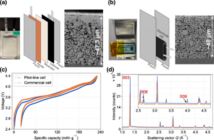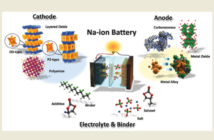Scientists have combined two very unconventional forms of carbon, one shaped like a soccer ball, the other a tiny diamond, to make a molecule that only conducts electricity in one direction. This little electronic component, known as a rectifier, could play a key role in shrinking chip components down to the size of molecules to enable faster, more powerful devices.
“We wanted to see what new, emergent properties might come out when you put these two ingredients together to create a ‘buckydiamondoid,'” said Hari Manoharan of the Stanford Institute for Materials and Energy Sciences (SIMES) at the Department of Energy’s SLAC National Accelerator Laboratory. “What we got was a basically a one-way valve for conducting electricity — clearly more than the sum of its parts.”
The research team, which included scientists from Stanford University, Belgium, Germany and Ukraine, reported its results September 9, 2014 in Nature Communications.
Most electric circuits have three basic components: a material that conducts electrons; rectifiers, which commonly take the form of diodes, to steer that flow in a single direction; and transistors to switch the flow on and off. Scientists combined two offbeat ingredients, buckyballs and diamonds, to create the new diode-like component.
Buckyballs, short for buckminsterfullerenes, are hollow carbon spheres whose 1985 discovery earned three scientists a Nobel Prize in chemistry. Diamondoids are tiny carbon cages bonded together as they are in diamonds, but weighing less than a billionth of a billionth of a carat. Both are subjects of a lot of research aimed at understanding their properties and finding ways to use them.
In 2007, a team led by researchers from SLAC and Stanford discovered that a single layer of diamondoids on a metal surface can efficiently emit a beam of electrons. Manoharan and his colleagues wondered: what would happen if they paired an electron-emitting diamondoid with another molecule that likes to grab electrons? Buckyballs are just that sort of electron-grabbing molecule.
For their study, diamondoids were produced in the SLAC laboratory of SIMES researchers Jeremy Dahl and Robert Carlson, who are world experts in extracting the tiny diamonds from petroleum. The were then shipped to Germany, where chemists at Justus-Liebig University figured out how to attach them to buckyballs.
The resulting buckydiamondoids, which are just a few nanometers long, were tested in SIMES laboratories at Stanford. A team led by graduate student Jason Randel and postdoctoral researcher Francis Niestemski used a scanning tunneling microscope to make images of the hybrid molecules and measure their electronic behavior.
They discovered the hybrid is an excellent rectifier: The electrical current flowing through the molecule was up to 50 times stronger in one direction, from electron-spitting diamondoid to electron-catching buckyball, than in the opposite direction. This is something neither component can do on its own.
“Buckyballs are easy to make — they can be isolated from soot — and the type of diamondoid we used here, which consists of two tiny cages, can be purchased commercially,” he said. “And now that our colleagues in Germany have figured out how to bind them together, others can follow the recipe. So while our research was aimed at gaining fundamental insights about a novel hybrid molecule, it could lead to advances that help make molecular electronics a reality.”
At UPS Battery Center, our goal isn’t to only sell batteries, we want to inform and teach you about the amazing world of batteries, electricity and energy. Please check back for more interesting, helpful and informative articles about batteries and electricity.
Related Articles:
Carbon Nanotubes: Replacing Silicon In Circuits
New Dual-carbon EV Battery Chemistry Breakthrough
Use of Carbon in Technological Advances
New Microbattery Holds Twice the Power of Current Microbatteries




